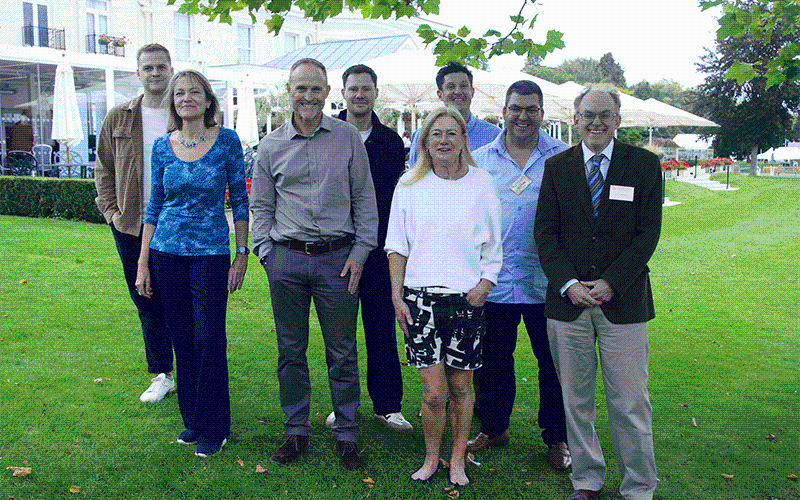
SoilsCon 2025 hits all the right spots for enthusiastic delegates
The event at Phyllis Court, Henley-on-Thames, organised by leading soil and landscape engineering consultants Tim O’Hare Associates LLP, took soil health and its role in delivering sustainable landscape projects as its theme. Over 140 delegates heard from eight inspiring speakers, each illustrating their presentations with case studies and sharing their personal expertise and experience with the landscape professionals who attended.
Never one to shy away from experimentation in horticulture, landscape architect, garden designer, and Gardeners’ Question Time panellist Bunny Guinness reflected in her presentation on the activities of gardeners’ past, and how good husbandry of the soil can be achieved by keeping things simple. She is an advocate of using green compost and digestate to ameliorate soils and acknowledged the benefits of ‘closed system’ organic gardening methods whilst stressing the importance of experimentation and monitoring to see what works.
Landscape architect Martin Knight delivered a fascinating insight to the regeneration of the former Mountbatten House – or the ‘Hanging Gardens of Basingstoke’, as the building is fondly referred to. Now re-named ‘Plant’, this Grade II Listed building has been refurbished, and Martin described the research undertaken to find the original James Russell designs for the 1970s modernist building’s roof gardens and landscape. Climate change and plant stock availability necessitated a regenerative rather than restorative approach by Martin’s team and, from their derelict condition in 2022, the roof gardens and landscape are once again flourishing, thanks to the use of specialist soils, an effective irrigation system, and a climate and site-appropriate planting scheme.
Tim O’Hare’s presentation is always eagerly anticipated and, this year, he took delegates back to the basic principles of what constitutes a healthy soil, how to protect them from degradation and compaction, and the crucial role soils play in delivering successful landscape projects. A key message was that soil profiles should match that of natural in-situ soils. Tree pits, for example, are still being designed with excessive depths of topsoil, Tim explained, which will lead to the soil becoming anaerobic and the tree failing. He said that the role of subsoil is just as important as that of topsoil when considering soil functions, with the lack of subsoil decompaction leading to major planting failures and significantly increased flood risk. Tim explained the relevance of soil pH measurement and the need for correct interpretation and spoke about soil considerations for species-rich habitats, contamination testing as part of the British Standard testing suite, and the contentious use of geotextile membranes.
Director of Refolo Landscape Architects, Cristina Refolo, spoke of the importance of soil to effective storm water management - 70% of London’s water supply relies on it. Healthy soil is, she explained, a natural sponge, which absorbs rainwater and releases it over time - sandy soils releasing water (and nutrients) quickly, clay soils retaining it. Cristina described the four pillars of SuDS – water quantity, quality, creating amenity, and increasing biodiversity – and the role of rain gardens within urban spaces. The ‘Sponge City’ concept, launched by the Chinese government in 2015, was explained and Auckland referenced as the world’s ‘spongiest city’ in terms of its ability to manage rainwater. Her chosen case study for her presentation was the refurbishment of a podium landscape scheme on an iconic 1966 Grade II Listed Brutalist building and garden in central London – ‘The Water Gardens’. The soils were crucial to the success of this complex scheme, as was getting detailed certification for them before they were installed.
‘Rootedness’ – or bringing wonder back into spaces – is how landscape architect Max Aughton described his approach to the design of central Manchester’s first park in over 100 years. In the 1700s, Mayfield was ‘a river in a meadow’ – then came the Industrial Revolution and the area was swamped by factories. When manufacturing went, nature tried to reclaim the space. Derelict for many years, it is now being regenerated, and Mayfield Park is the first completed part of that regeneration. A really challenging site of ‘made’ ground, Max explained that soil remediation and the protection of groundwater was crucial. An area of the river covered by a culvert was opened up and flood capacity designed into the park to cope with the wet Manchester climate; the entire park is, in fact, a SuDS system. Throughout the green and play spaces, architectural items from the site’s industrial heritage have been incorporated, and the purple planting palette is a nod to the site’s 19th century factories manufacturing indigo dye for Manchester’s cotton industry.
Tim White, Senior Associate at Tim O’Hare Assoiates, said that soil health is all about soil ‘quality’ – how good it is, and how well it functions as a living ecosystem. He described the physical, chemical and biological properties of soil and the crucial role played by organic matter (OM) in soils as it breaks down and releases nutrients. The more that soil is agitated, the more microbial activity is stimulated resulting in the loss of OM, he said. Referencing soils on construction sites, Tim explained the importance of correct onsite storage of soils during construction, and its correct reinstatement, including the decompaction of subsoil. A Soil Resource Survey at the planning stage of a scheme provides a baseline for maintaining or improving soil health, and the site-specific Soil Management Plan gives instructions on how to stockpile correctly, how to prepare the subsoil for application of the topsoil, and actions to take prior to planting. Tim referenced North West Cambridge – a 150-hectare mixed use development on the outskirts of the city of Cambridge - in the context of soil health and management during and post-construction.
Looking at soils from the ‘manufactured’ perspective, John Coles of Bury Hill Landscape Supplies gave delegates a comprehensive overview of how manufactured topsoils are produced and why they can be superior to ‘as dug’ soils in terms of consistency, sustainability, safety, and designability. He stressed the lengths to which Bury Hill Landscape Supplies go in their product validation, having all ingredients in their soils tested individually, and testing the finished products to the very strictest ‘soils for residential production of home grown produce’ standard. He cited The Newt, Somerset, as a scheme where his company quoted for, tested, and installed the specified soils. John actively encourages the re-use of on-site soils but again stressed the need for stringent testing, including for physical and chemical contamination. He also gave delegates some useful pointers when buying manufactured soils.
The closing presentation for a packed day came from Simon Parfey of SoilBioLab. His fascinating presentation kept everyone alert to the very end of the afternoon as he showed AI-generated animations of the hive of activity that is a healthy soil. The spaces between the soil aggregate are vital, he explained, for the movement of microorganisms, and organic matter is ‘super important’ to a healthy soil. The soil around plant roots is a haven for life, with different groups of microbes stimulated by different plants. The microbes break down bacteria, which in turn feed nutrients back to the plant. He explained that there are no ‘good’ or ‘bad’ bacteria, their function is to do what they each do best and if a plant is healthy the ‘good’ bacteria out-competes the ‘bad’. Microbes can also help to build carbon in soils. He said that soil life reflects soil health and function and that soil testing – to achieve a baseline from which to monitor and measure soil over time – is a fundamental part of soil protection and management.
Supporting the conference on the day were exhibitors Barnes Associates, Bourne Amenity, Bury Hill Landscape Supplies, Green-tech, and The Woodhorn Group, and the popular Soil Surgery – where Tim O’Hare and his colleagues helped delegates with their soil questions – took place in the networking and lunch breaks.
The date and theme for the next SoilsCon will be released in the New Year.

